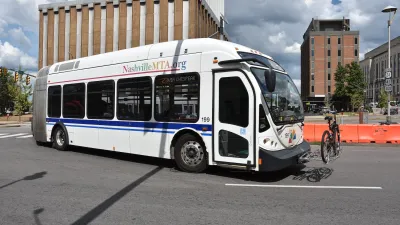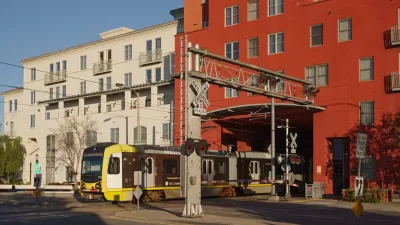Transit-oriented developments multiplied and held their values comparatively well in the housing crisis. In this article, Josh Stephens explores whether the trend will continue post-recession, or if sprawl is poised for a comeback.
"By the middle of 2008 it had become apparent that a trend which had dominated American life for the better part of the past century was coming to a close. What began with Lewis and Clark, covered wagons, and the conquest of the Frontier appeared to be ending in an inglorious mess of bad mortgages, credit default swaps, and zombie houses more prone to causing nightmares than to fulfilling the American dream.
...For all the suffering that has come with it, this chaos has helped spur the development of more urban sites, particularly near mass transit stations. Some Pollyannas have even gone so far as to proclaim the death, or at least the withering, of sprawl.
...'The pockets of neighborhoods that seem to have weathered this economic trauma we’ve had, particularly in the housing market, have been these great little accessible neighborhoods near transit stations, particularly in central cities or inner-ring neighborhoods,' said Robert Cervero, Professor of City and Regional Planning at the University of California, Berkeley.
...In total, the National TOD Database (toddata.cnt.org) estimates that over 1,500 stations are in the development pipeline in 54 cities. And while these projects have served to shuttle commuters, they also can instigate profound changes in cities’ urban fabrics. If designed and developed well, many of them could become new, distinct communities: microcosms of what some planners say a city should be.
'We’re seeing a heightened desirability after the real estate crash,' said Geoff Anderson, president of Reconnecting America. 'The markets are really reflecting the demand that’s out there where the places around transit are walkable and closer to centers.'
...Proponents of TOD are hoping that, before long, it becomes so commonplace that it is no longer seen as a typology apart and instead becomes the norm anywhere public transit can support higher residential densities and supporting commercial uses.
FULL STORY: USA TOD-ay

Alabama: Trump Terminates Settlements for Black Communities Harmed By Raw Sewage
Trump deemed the landmark civil rights agreement “illegal DEI and environmental justice policy.”

Planetizen Federal Action Tracker
A weekly monitor of how Trump’s orders and actions are impacting planners and planning in America.

The 120 Year Old Tiny Home Villages That Sheltered San Francisco’s Earthquake Refugees
More than a century ago, San Francisco mobilized to house thousands of residents displaced by the 1906 earthquake. Could their strategy offer a model for the present?

Opinion: California’s SB 79 Would Improve Housing Affordability and Transit Access
A proposed bill would legalize transit-oriented development statewide.

Record Temperatures Prompt Push for Environmental Justice Bills
Nevada legislators are proposing laws that would mandate heat mitigation measures to protect residents from the impacts of extreme heat.

Downtown Pittsburgh Set to Gain 1,300 New Housing Units
Pittsburgh’s office buildings, many of which date back to the early 20th century, are prime candidates for conversion to housing.
Urban Design for Planners 1: Software Tools
This six-course series explores essential urban design concepts using open source software and equips planners with the tools they need to participate fully in the urban design process.
Planning for Universal Design
Learn the tools for implementing Universal Design in planning regulations.
Clanton & Associates, Inc.
Jessamine County Fiscal Court
Institute for Housing and Urban Development Studies (IHS)
City of Grandview
Harvard GSD Executive Education
Toledo-Lucas County Plan Commissions
Salt Lake City
NYU Wagner Graduate School of Public Service





























